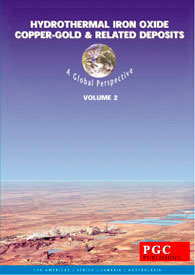 Comparison
of
the
Geology
of Proterozoic Iron Oxide
Deposits in the Adirondack and Mid-Atlantic Belt of Pennsylvania, New
Jersey,
and New York
Comparison
of
the
Geology
of Proterozoic Iron Oxide
Deposits in the Adirondack and Mid-Atlantic Belt of Pennsylvania, New
Jersey,
and New York
Kurt C. Friehauf - Dept. of Physical Sciences,
Kutztown
Univ., Kutztown, PA 19530
Robert C. Smith, II - Pennsylvania Geol.
Survey,
Harrisburg, PA 17105
Richard A. Volkert - New Jersey Geol. Survey, Trenton, NJ, 08625
Friehauf,
Kurt C., Smith, Robert C., II, and Volkert, Richard A., 2001,
Comparison of the Geology of Proterozoic Iron Oxide Deposits in the
Adirondack And Mid-Atlantic Belt of Pennsylvania, New Jersey, and New
York: in Potter, Mike, ed.,
Hydrothermal
Iron-Oxide
Copper-Gold
& Related Deposits a Global
Perspective - Volume 2: Australian Mineral Foundation Monograph series,
Porter,
T.M.,
ed., PGC
Publishing, Australia, p. 247-252.
Abstract
Proterozoic
hydrothermal iron oxide deposits occur within two metallogenic belts in
the
northeastern U.S.: the Adirondack
region, and the Mid-Atlantic (Reading Prong) belt.
A 175 km wide belt of Paleozoic cover separates these two
regions, although some iron deposits occur in Proterozoic rocks near
the
unconformity, suggesting a possible continuation beneath the cover. Although potentially part of the same
continuous metallogenic province sharing similar mineralogy, host rock
composition, hydrothermal alteration, deposits in the two regions
differ in
degree of deformation. Differences in
the degree of metamorphic deformation fuel the debate of the relative
timing of
mineralization, igneous activity, and metamorphism.
Generally less deformed textures in the Adirondack deposits led
workers in the New York deposits to conclude iron ores in the
Adirondacks are
associated with anorogenic granites that post-date peak metamorphism. Folded iron ores in granitic gneiss of the
Mid-Atlantic belt suggest some deposits in eastern Pennsylvania,
northern New
Jersey, and southern New York predate peak metamorphism.
REE-enriched deposits in both belts are
characterized by abundant apatite, tourmaline, and manganese
concentrations, as
well as the presence of hematite-chlorite alteration in addition to
magnetite. Unlike deposits hosted
exclusively within granite gneisses, deposits within supracrustal rocks
commonly contain significant sulphides and so are potential hosts for
copper mineralization.

